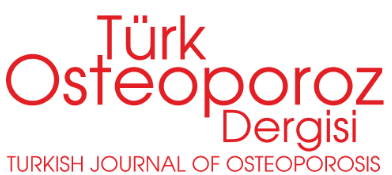SummaryAims: The current method for screening osteoporosis involves dual-energy x-ray absorptiometry (DEXA). The aim of this study to determine specifity and sensitivity of the calcaneal quantative ultrasound (QUS) and radiographic absorbsiometri (RA). Materials and Methods: We enrolled a total of 69 community-dwelling people aged between 30-81 years. Of all the patients phalangeal bone mineral density (BMD) was measured using RA; calcaneal BMD was measured by using QUS; lumbar spine and hip regions BMD was measured using by DEXA. The screening results conducted by QUS and RA were compared with the DEXA results.Results: While QUS measurements revealed osteopenia in 21 cases (30.4%) and osteoporosis in 31 cases (44.9%); RA measurements revealed osteopenia in 21 cases (30.4%) and osteoporosis in 33 cases (47.8%). Whereas according to lumbar vertebra DEXA results: 21 cases revealed osteopenia, and 30 cases revealed osteoporosis; according to hip DEXA results: 26 cases revealed osteopenia, and 19 cases revealed osteoporosis. The sensitivity, specificity, positive predictive value, and negative predictive value for identifying cases with osteoporosis by QUS were 66.7%, 78.8%, 77.4%, 68.4%, respectively, and by RA were 75%, 81.8%, 81.8%, 75%, respectively. Conclusion: QUS and RA seem to be valid and practical method. Due to highly concordant RA and lumbar vertebral DEXA results, RA appears to be a useful technique for assessing osteoporosis. (Osteoporoz Dünyasindan 2006; 12: 43-6)Key words: Osteoporosis, dual energy-ray absorbsiometry, phalangeal radiographic absorbsiometri, calcaneal quantitative ultrasound
Article in Turkish(Use the link for full-text in Turkish)
Giris
Osteoporoz, özellikle postmenopozal dönemde sik karsilasilan, ciddi komplikasyonlarla sonuçlanabilecek önemli bir halk sagligi sorunudur. Osteoporoz tanisinda günümüzde en geçerli teknik çift-enerji x-isin absorpsiyometridir (DEXA). Ancak DEXAnin pahali bir tani yöntemi olmasi ve toplum taramalarinda tasinma ve uygulanabilme zorlugu bulunmasi osteoporoz taramalarinin yaygin bir sekilde yapilmasini kisitlamaktadir (1). Osteoporoz açisindan DEXA ile degerlendirilmesi gereken toplum kesimini belirlemek amaciyla daha ucuz ve hizli bir tarama sekli olan kantitatif ultrason (QUS) ve radyografik absorpsiyometri (RA) kullanilan yöntemlerdir (2,3). Bizim bu çalismadaki amacimiz osteoporoz taramalarinda sikça kullanilan iki yöntemin duyarlilik ve özgüllügünü ortaya koymakti.



